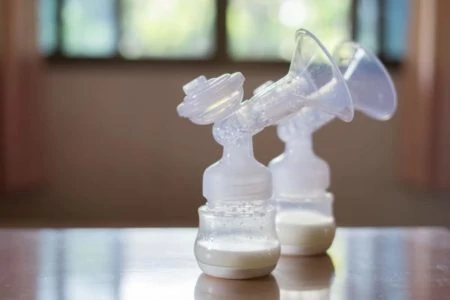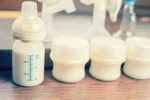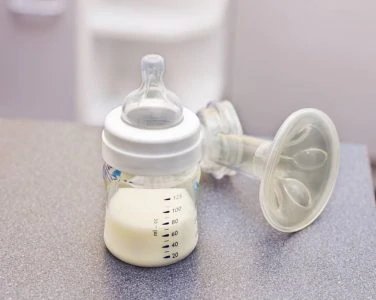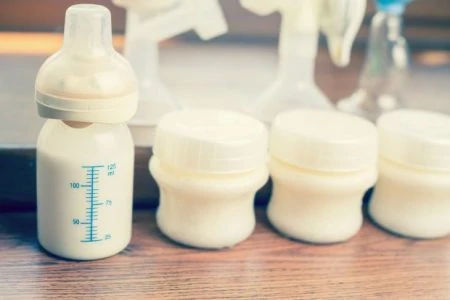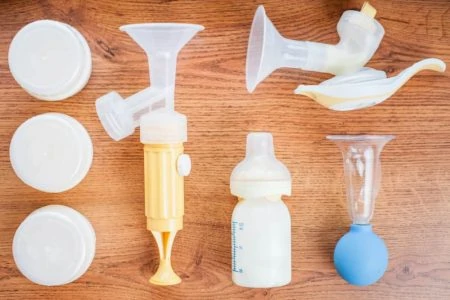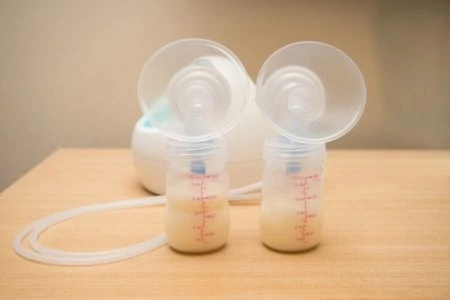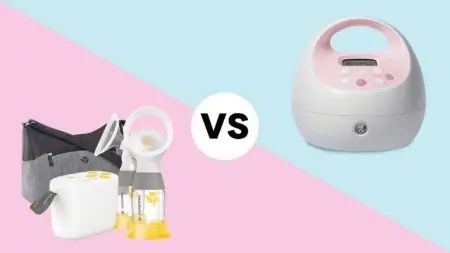As breastfeeding mamas, the breast pump is one of our most trusted allies. It allows us to create a freezer stash of precious milk, helps relieve engorgement, and can also help maintain our milk supply.
But choosing the best breast pump is only the first step of many to maximize the benefits of this handy little machine.
In this guide, we’ll discuss when to start pumping, explain how to use your pump, and answer the most common questions we’re asked about pumping.
Key Takeaways
- Start pumping breast milk in the morning and space breastfeeding sessions and pumping sessions about an hour apart for occasional pumpers, or pump every 2.5 to 3 hours for exclusive pumpers.
- Choose and use a breast pump according to your needs: manual pumps for occasional use and electric pumps for frequent use.
- Properly fitting breast shields (flanges) are crucial for successful pumping; choose based on nipple size, not breast size.
- Clean breast pump parts thoroughly after use and follow hygiene tips to maintain healthy breastfeeding and pumping practices.
When Should I Use My Breast Pump?
Women who usually breastfeed their babies and only pump occasionally should pump milk in the morning, when they are likely to get the most. Space breastfeeding sessions and pumping sessions about an hour apart. You can either pump an hour before you expect your baby to be hungry again or an hour after they breastfeed. That will give you enough milk for both sessions (1).
Women who pump exclusively and don’t feed their baby at the breast should pump about every 2.5 to 3 hours. Efficiently emptying your breast milk signals your body to make more.
How Do I Use a Breast Pump?
How you use your breast pump will depend on the type of pump you choose: manual or electric.
Manual pumps are cheap, small, portable, and easy to operate. Because you supply the hand power to express your milk, it takes a little more time and effort.
With a manual pump, you can only express one breast at a time, so it takes twice as long as most electric pumps. We recommend a manual pump for moms who only pump occasionally.
Moms who will be pumping a lot will want to consider using a double electric pump that allows them to pump both breasts at once. It’s a time saver, and you won’t have to do any physical work. However, electric pumps are much more expensive than manual pumps.
How to Use a Manual Breast Pump
- First, you need to encourage your milk let-down. Let-down is the process of milk moving from the back of the breast to the front. You can gently massage your breasts or place a warm washcloth on your breasts to encourage let-down.
- Cover your nipple with the pump’s breast shield, and make sure it forms a tight seal.
- Use one hand to hold the shield in the correct place, and start squeezing the pump’s handle with the other hand.
- If milk isn’t flowing easily, lean forward, and put gravity to work.
- Keep pumping until your flow starts to slow.
How to Use an Electric Breast Pump
- Cover your nipples with the pump’s breast shields.
- Turn the machine on.
- Pay attention to your comfort level. If the suction hurts, turn it down. If your milk is coming out too slowly, increase the suction.
- Once your milk starts to slow, turn off the machine, and break the pump’s seal on your breast with your finger.
Other Important Tips to Remember
- No matter which pump you use, you must ensure your hands and pumping equipment are clean before you begin.
- Your milk won’t come out immediately – it’s not like turning on a faucet.
- Don’t pull off the breast shields while your electrical pump is still on unless you love pain. Instead, turn off your pump. The suction will be gone, but the shields will still be suctioned to your breasts. Use your finger to break the seal, then gently remove the breast shields.
What are Breast Shields?
Breast shields, also called flanges, are one of the most important breast pump features. Proper fitting breast shields are crucial to your success while pumping breast milk. Breast shields are the cup-like pieces you put on your breasts.
You choose your breast shield based on your nipple size, not your breast size. And if you’ve used a different pump in the past, don’t depend on the size of breast shield you once used. Flange sizes aren’t uniform from brand to brand, and your pre-birth nipples may not stay that size after you have your baby.
When Size Matters
You don’t want to purchase a flange that is too big either because your breast, not just the nipple, will be sucked in. That can mess with your breast milk flow. Breastfeeding can be challenging enough without your milk supply dwindling.
If you begin breastfeeding and the process is painful rather than just uncomfortable, you should reevaluate the size of your breast shields.
How Do I Clean a Breast Pump?
Some pumps may have separate cleaning instructions, and some will be easier to clean than others.
But, in general, you’ll want to use hot water to rinse every piece that comes in contact with breast milk or wash them with soapy water before rinsing them well. Some pieces can be put in the top rack of the dishwater (2).
Let the parts air dry. Some breast pump parts can be sanitized in a baby bottle sanitizer or a bag in the microwave.
Tips for breast-pumping hygiene:
- Avoid scented creams, lotions, or nipple creams.
- Change your breast pads at least twice a day, if you’re using them.
- Wear light, loose clothing made of breathable natural fabric.
- Wear a clean nursing bra every day.
- Wash your hands before every feed.
- Clean your breast pump as soon as possible after using it.
- Shower frequently, and give your breasts a quick wash before a feed if you’re sweaty from exercise.
- Use warm water to rinse your nipples throughout the day, and dry with a clean, soft towel.
Tips for Expressing More Milk
Your breasts work on a kind of feedback system: when they’re full and there’s nobody to drink the milk, your body gets the message and slows production. However, if your breast milk is “flying off the shelves” faster than your body can restock it, your supply will increase to match the demand.
This means that if you want to increase supply, you need to remove milk from your breasts often, rather than waiting for them to fill up (3).
Even if your baby isn’t drinking yet, keep on expressing milk so you establish a regular supply. It’s tempting to think that the more you pump, the less milk there will be for your baby, but it’s actually the opposite. Getting used to regularly draining and refilling your breasts means your body is more able to adjust to your baby’s needs.
If you do end up with extra breast milk, it can always be frozen. Focus on maintaining an even, steady flow, and you’ll soon come into sync with your baby.
Other Pumping Tips and Hacks
As long as your baby is gaining weight on your milk, you’re producing enough (4). But if you’re worried your supply is low, here are some other things you can do to increase it:
- Efficient nursing: Make sure your baby is nursing well and has a good latch. A suckling baby is the best way to drain your breasts completely.
- Nurse frequently: Aim to breastfeed every 2 hours during the day and 3 hours during the night.
- Galactagogues: Try using a substance that can increase milk supply. However, always consult your doctor before taking new medication while breastfeeding.
- Pump to increase supply: Try pumping for a few minutes after the last drop to encourage flow.
- Keep healthy: You always need a balanced diet with plenty of rest and fluids, but you need this even more so when breastfeeding.
- Alternate: Offer both breasts at feedings, and switch sides during a feed to encourage even milk supply.
